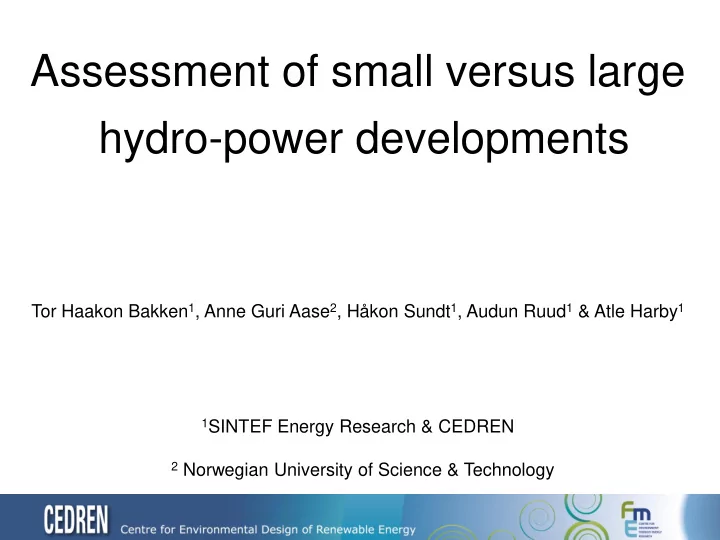

Assessment of small versus large hydro-power developments Tor Haakon Bakken 1 , Anne Guri Aase 2 , Håkon Sundt 1 , Audun Ruud 1 & Atle Harby 1 1 SINTEF Energy Research & CEDREN 2 Norwegian University of Science & Technology
Large plants – large impacts? Long history of conflicts Resistance formed the environmental movement Three Gorges, China Source: Statkraft
Development of Alta-Kautokeino river basin, Norway 3
Three Gorges project, China 4
Photo: Norsk Grønnkraft Photo: BKK Photo: Statkraft Small plants – small impacts? Accumulated effects?
Small plants – small impacts? Accumulated effects? Photo: Norsk Grønnkraft Photo: BKK Photo: Statkraft
Photo: Norsk Grønnkraft Photo: BKK Photo: Statkraft Small plants – small impacts? Accumulated effects?
Photo: BKK Photo: Statkraft
Photo: BKK Photo: Statkraft
Photo: BKK Photo: Statkraft
Photo: BKK Photo: Statkraft
Photo: BKK Photo: Statkraft
Photo: BKK Photo: Statkraft
An extreme example from China Small hydropower (< 50 MW): Large (enormous) Three Gorges: • More than 1000 plants built • 1 huge plant • Producing 96 TWh/a • Producing 2.5 TWh/a In order to produce the same energy output from Three Gorges project, approximately 40 000 small hydropower plants (< 50 MW) must be constructed. What are the accumulated environmental (and social) impacts?
Climate change asks for development of renewable energy How to realise the EU Renewable Energy Sources (RES) Directive? Many small-scale? Wind power farms? Large hydropower?
Approach for comparison Similar volumes of energy production Environmental impacts from one large plant compared to accumulated impacts from many small
Approaches for comparison Comparison of environmental impacts across types of energy (electricity) production technologies: • Few studies published • Lack of mature and well-proven methodological frameworks • IPCC SRREN-report (2011) suffers from lack of studies The quality of the energy production should also be considered: • Regulated versus non-regulated • Security/reliability of supply / hydrological risk • Access to grid with sufficient capacity
Comparison of environmental impacts (1) Rule of thumb; environmental impacts are roughly proportional to area inundated, (e.g. Egre & Milewski (2002)) Inundated area Outcome: Small-scale plants without reservoirs come out better than large reservoir plants Developed for reservoir plants? What about large run-of-the-river Environmental impacts plants?
Comparison of environmental impacts (2) Comparison of impounded river lengths, given the need to produce 2.8 TWh/a (Schmutz et al. 2010): Outcome: Reservoir plants better than all other strategies Simplified to include only impounded rivers as the impact
Comparison of environmental impacts (3) Reduction in areas with no prior or major encroachments (INON-areas); (Directorate for Nature Management (DN)) Outcome: • Better to develop new energy resources in already exploited areas? • Selective exploitation of nature types (Erikstad et al., 2009). Ecosystem response Pressure Source: from Carstensen & Heiskanen, 2007
Comparison of environmental impacts (EIAs) Use of standardised Environmental Impact Assessments (EIA) for comparison (Bakken et al. 2012): EIAs in Norway and internationally: A standardised and complete set of environmental topics to investigated (given by guidelines) Value • Landscape small large Large negative large positive • Biodiversity • Fish • Water quality etc. Extent A standardised way to classify impact level (Statens Vegvesen, 2006)
Data 27 on small-scale HPPs • Accumulation of impacts • Interpretation of qualitative data • Expert judgments Sum inst. capacity: 112 MW Sum production: 390 GWh/a
'Average HP plant' Data on large HPP EIA EIA 'EIA' Average plant: Installed cap.: 54 MW Production: 350 GWh Vestsideelvane Vigdøla Scientific reports Trollheim
Comparison of impacts Large Many small 112 MW 54 MW 390 GWh 350 GWh Accumulated impacts Average large HPP from 27 small HPPs
Results: Comparison of impacts ÷ +
Comments to the results Small-scale HP scores 'worse' (more negative/less positive) on the following topics: Ice conditions/local climate Recreation Fish Nature resources ► Large HP scores 'worse' (more negative) in the category water temperature ► The scores differ with only one impact level
Points of discussion from our study Quality of available information; completeness, precision. Accumulation of impacts from many small projects How to compare 'non-comparable environmental qualities'? Other aspects affecting the environmental performance; professionalism/competence in developer's organization, monitoring/control, corporate responsibility (CR) Qualities of the energy production
Conclusions from our study The results show a slight tendency that large hydropower has a lower degree of impacts than many small-scale projects. The results are, however, marginal in the favour of large hydropower. Lack of precision in the data and weak methodological foundation introduce uncertainty in the results. Taking into account other benefits such as the provision of regulated power, it is reasonable to assume that a few large hydropower projects will produce electricity to a lower environmental cost compared to many small projects. The study raises a more fundamental question on valuation of environmental qualities.
Is salmon more important than moss? Who to assign values/priorities to the environment? • Researchers? • Management authorities? • The majority? • Other stakeholders?
Follow-up study recently started
Follow-up study recently started
Follow-up study recently started
Improvements of methodology MSc-study started up this Fall, finalized Summer 2013 Includes also wind power Uses a standardized set of parameters relevant for all production technologies: areas directly affected by the projects Habitat, biodiversity reduction in untouched nature (INON) visibility Landscape impacts on red-listed species Biodiversity ('Party-stopper') main problem of concern Conflict
Improvements of methodology Based on GIS- data and tools Preliminary testing promising
Recommend
More recommend